Financial Accounting: AASB 138/IAS 38 - Intangible Asset Recognition
VerifiedAdded on 2023/04/22
|9
|2484
|260
Report
AI Summary
This report provides a detailed analysis of the financial accounting treatment of intangible assets, focusing on the application of AASB 138/IAS 38 standards. It examines the case of Technology Enterprise Ltd and its research and development project to modify battery recharging technology. The report covers key aspects such as the recognition, measurement, and amortization of intangible assets, including the treatment of research costs and the development of intangible assets. It also discusses the importance of disclosures and the comparability of financial statements, highlighting the challenges in achieving uniformity in valuation and measurement practices. The report concludes with recommendations for improving accounting standards to enhance the interpretability and comparability of financial information for investors and financial users. Desklib offers a wealth of resources, including solved assignments and past papers, to support students in their academic pursuits.
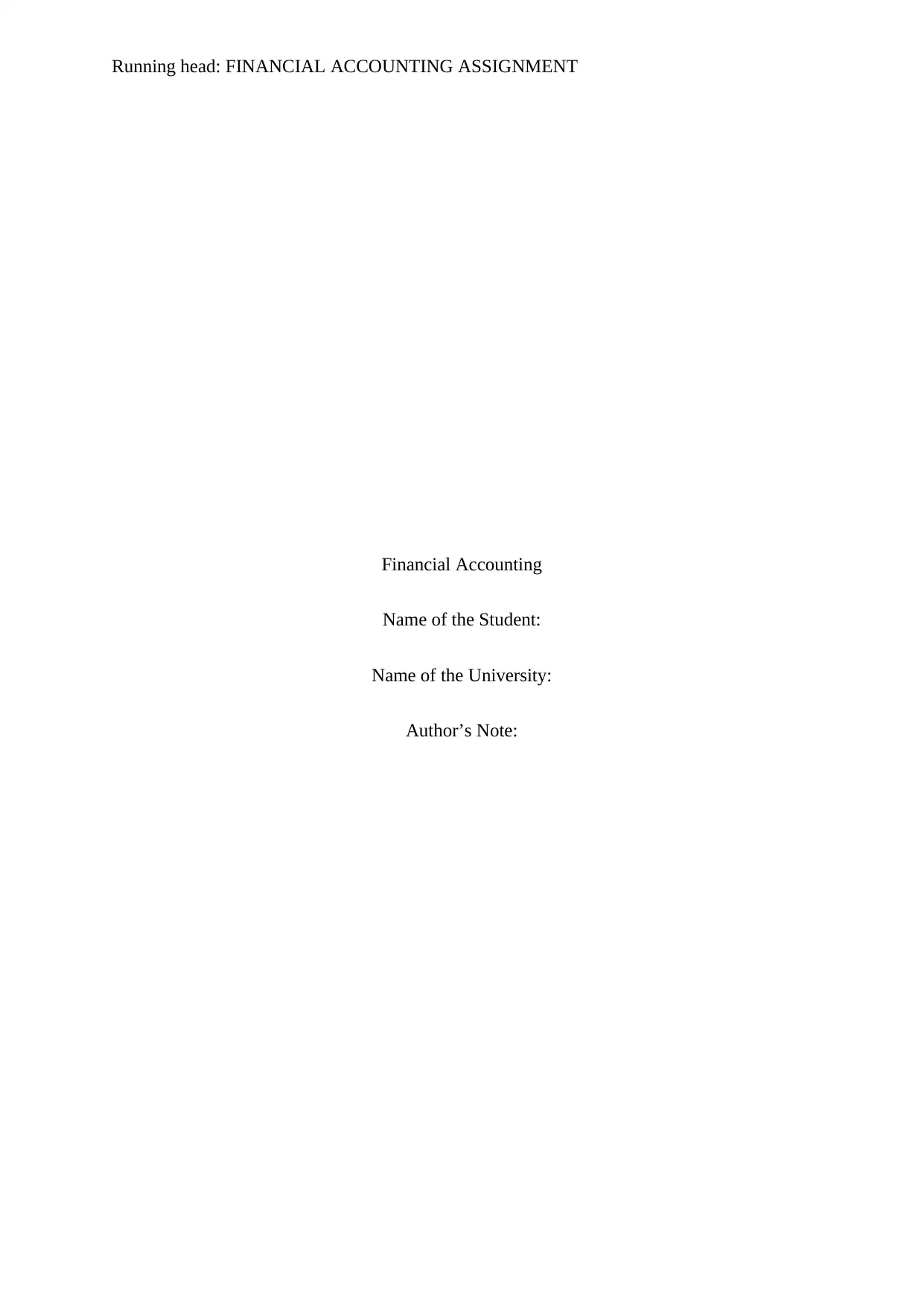
Running head: FINANCIAL ACCOUNTING ASSIGNMENT
Financial Accounting
Name of the Student:
Name of the University:
Author’s Note:
Financial Accounting
Name of the Student:
Name of the University:
Author’s Note:
Paraphrase This Document
Need a fresh take? Get an instant paraphrase of this document with our AI Paraphraser
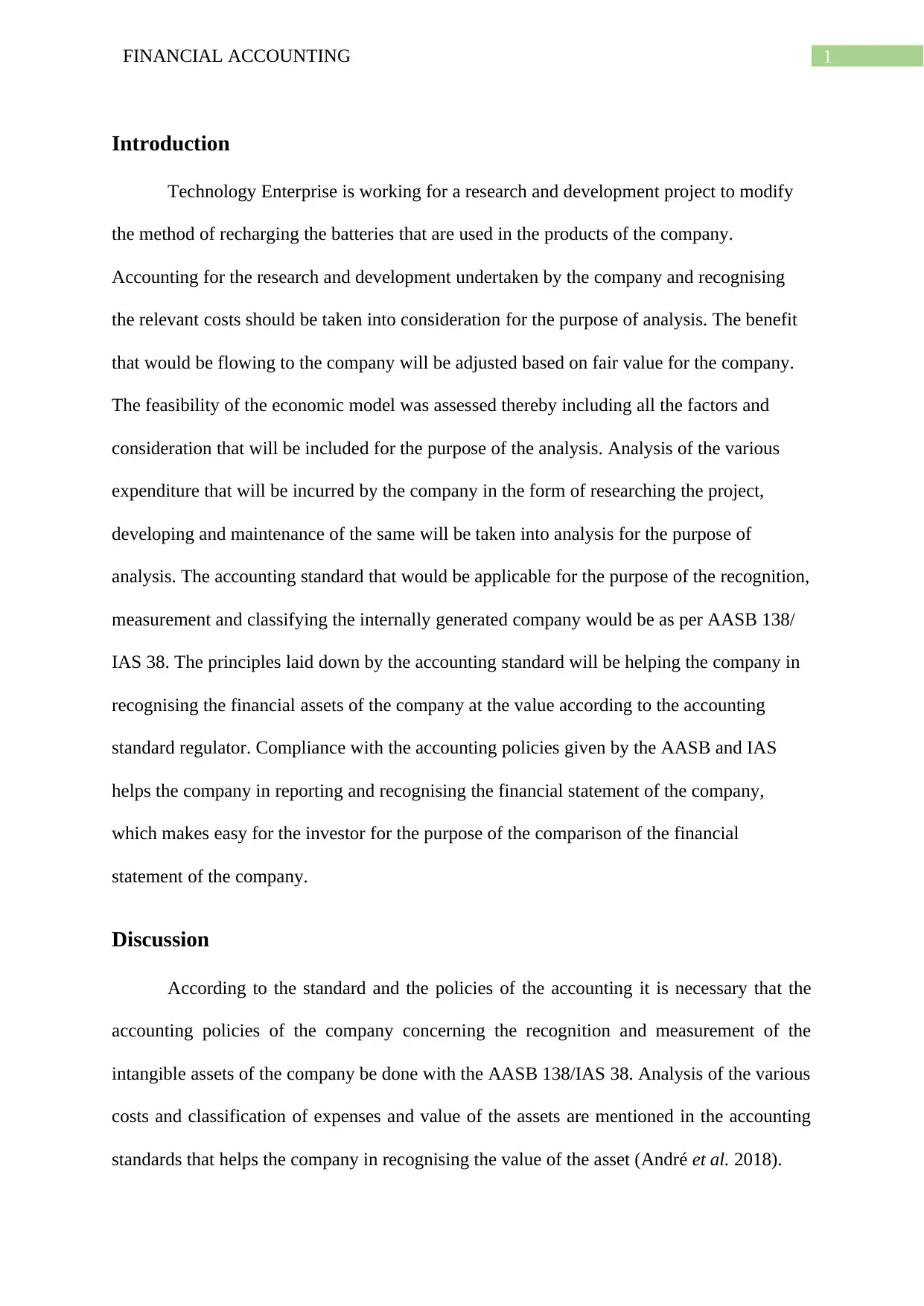
1FINANCIAL ACCOUNTING
Introduction
Technology Enterprise is working for a research and development project to modify
the method of recharging the batteries that are used in the products of the company.
Accounting for the research and development undertaken by the company and recognising
the relevant costs should be taken into consideration for the purpose of analysis. The benefit
that would be flowing to the company will be adjusted based on fair value for the company.
The feasibility of the economic model was assessed thereby including all the factors and
consideration that will be included for the purpose of the analysis. Analysis of the various
expenditure that will be incurred by the company in the form of researching the project,
developing and maintenance of the same will be taken into analysis for the purpose of
analysis. The accounting standard that would be applicable for the purpose of the recognition,
measurement and classifying the internally generated company would be as per AASB 138/
IAS 38. The principles laid down by the accounting standard will be helping the company in
recognising the financial assets of the company at the value according to the accounting
standard regulator. Compliance with the accounting policies given by the AASB and IAS
helps the company in reporting and recognising the financial statement of the company,
which makes easy for the investor for the purpose of the comparison of the financial
statement of the company.
Discussion
According to the standard and the policies of the accounting it is necessary that the
accounting policies of the company concerning the recognition and measurement of the
intangible assets of the company be done with the AASB 138/IAS 38. Analysis of the various
costs and classification of expenses and value of the assets are mentioned in the accounting
standards that helps the company in recognising the value of the asset (André et al. 2018).
Introduction
Technology Enterprise is working for a research and development project to modify
the method of recharging the batteries that are used in the products of the company.
Accounting for the research and development undertaken by the company and recognising
the relevant costs should be taken into consideration for the purpose of analysis. The benefit
that would be flowing to the company will be adjusted based on fair value for the company.
The feasibility of the economic model was assessed thereby including all the factors and
consideration that will be included for the purpose of the analysis. Analysis of the various
expenditure that will be incurred by the company in the form of researching the project,
developing and maintenance of the same will be taken into analysis for the purpose of
analysis. The accounting standard that would be applicable for the purpose of the recognition,
measurement and classifying the internally generated company would be as per AASB 138/
IAS 38. The principles laid down by the accounting standard will be helping the company in
recognising the financial assets of the company at the value according to the accounting
standard regulator. Compliance with the accounting policies given by the AASB and IAS
helps the company in reporting and recognising the financial statement of the company,
which makes easy for the investor for the purpose of the comparison of the financial
statement of the company.
Discussion
According to the standard and the policies of the accounting it is necessary that the
accounting policies of the company concerning the recognition and measurement of the
intangible assets of the company be done with the AASB 138/IAS 38. Analysis of the various
costs and classification of expenses and value of the assets are mentioned in the accounting
standards that helps the company in recognising the value of the asset (André et al. 2018).
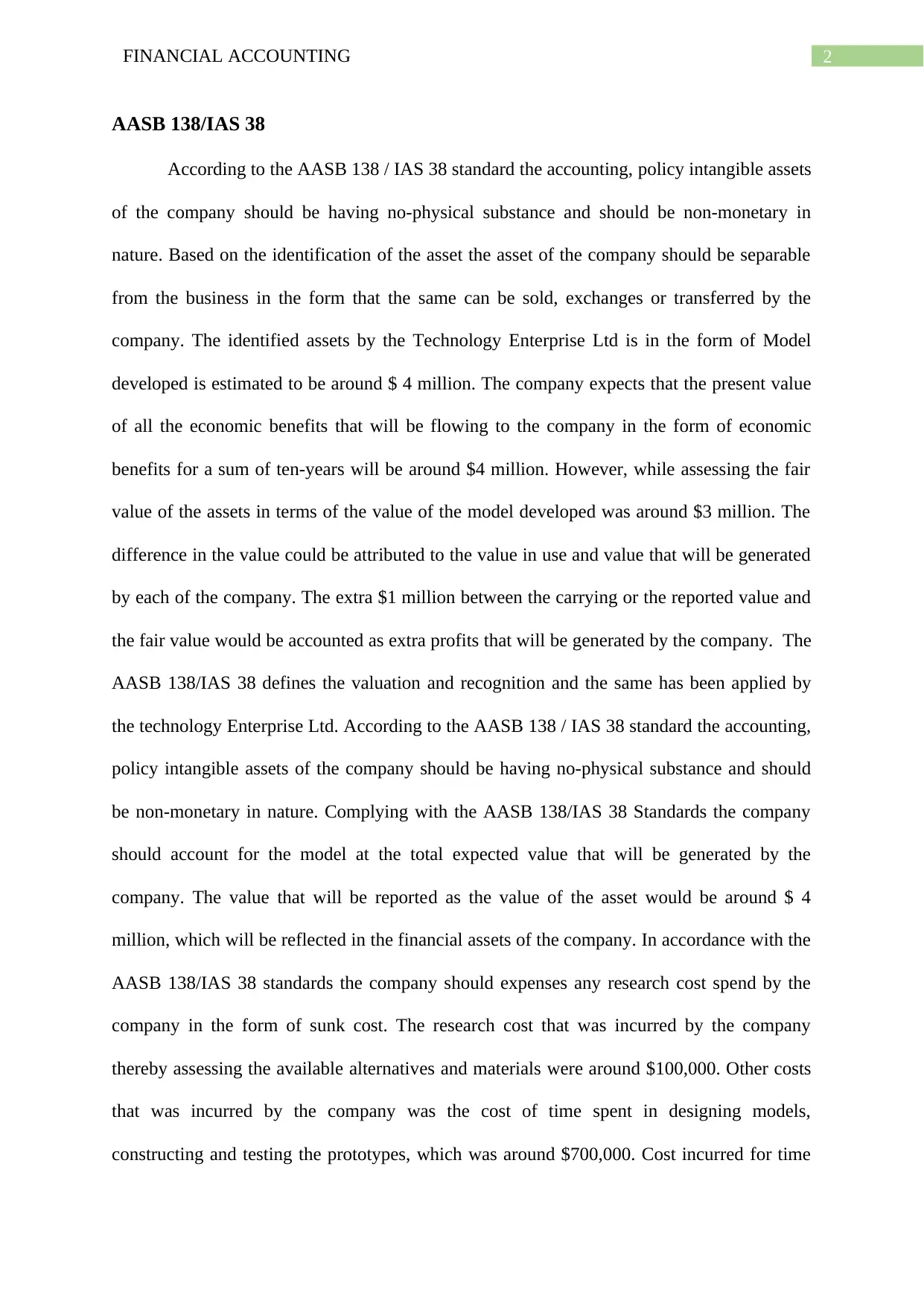
2FINANCIAL ACCOUNTING
AASB 138/IAS 38
According to the AASB 138 / IAS 38 standard the accounting, policy intangible assets
of the company should be having no-physical substance and should be non-monetary in
nature. Based on the identification of the asset the asset of the company should be separable
from the business in the form that the same can be sold, exchanges or transferred by the
company. The identified assets by the Technology Enterprise Ltd is in the form of Model
developed is estimated to be around $ 4 million. The company expects that the present value
of all the economic benefits that will be flowing to the company in the form of economic
benefits for a sum of ten-years will be around $4 million. However, while assessing the fair
value of the assets in terms of the value of the model developed was around $3 million. The
difference in the value could be attributed to the value in use and value that will be generated
by each of the company. The extra $1 million between the carrying or the reported value and
the fair value would be accounted as extra profits that will be generated by the company. The
AASB 138/IAS 38 defines the valuation and recognition and the same has been applied by
the technology Enterprise Ltd. According to the AASB 138 / IAS 38 standard the accounting,
policy intangible assets of the company should be having no-physical substance and should
be non-monetary in nature. Complying with the AASB 138/IAS 38 Standards the company
should account for the model at the total expected value that will be generated by the
company. The value that will be reported as the value of the asset would be around $ 4
million, which will be reflected in the financial assets of the company. In accordance with the
AASB 138/IAS 38 standards the company should expenses any research cost spend by the
company in the form of sunk cost. The research cost that was incurred by the company
thereby assessing the available alternatives and materials were around $100,000. Other costs
that was incurred by the company was the cost of time spent in designing models,
constructing and testing the prototypes, which was around $700,000. Cost incurred for time
AASB 138/IAS 38
According to the AASB 138 / IAS 38 standard the accounting, policy intangible assets
of the company should be having no-physical substance and should be non-monetary in
nature. Based on the identification of the asset the asset of the company should be separable
from the business in the form that the same can be sold, exchanges or transferred by the
company. The identified assets by the Technology Enterprise Ltd is in the form of Model
developed is estimated to be around $ 4 million. The company expects that the present value
of all the economic benefits that will be flowing to the company in the form of economic
benefits for a sum of ten-years will be around $4 million. However, while assessing the fair
value of the assets in terms of the value of the model developed was around $3 million. The
difference in the value could be attributed to the value in use and value that will be generated
by each of the company. The extra $1 million between the carrying or the reported value and
the fair value would be accounted as extra profits that will be generated by the company. The
AASB 138/IAS 38 defines the valuation and recognition and the same has been applied by
the technology Enterprise Ltd. According to the AASB 138 / IAS 38 standard the accounting,
policy intangible assets of the company should be having no-physical substance and should
be non-monetary in nature. Complying with the AASB 138/IAS 38 Standards the company
should account for the model at the total expected value that will be generated by the
company. The value that will be reported as the value of the asset would be around $ 4
million, which will be reflected in the financial assets of the company. In accordance with the
AASB 138/IAS 38 standards the company should expenses any research cost spend by the
company in the form of sunk cost. The research cost that was incurred by the company
thereby assessing the available alternatives and materials were around $100,000. Other costs
that was incurred by the company was the cost of time spent in designing models,
constructing and testing the prototypes, which was around $700,000. Cost incurred for time
⊘ This is a preview!⊘
Do you want full access?
Subscribe today to unlock all pages.

Trusted by 1+ million students worldwide
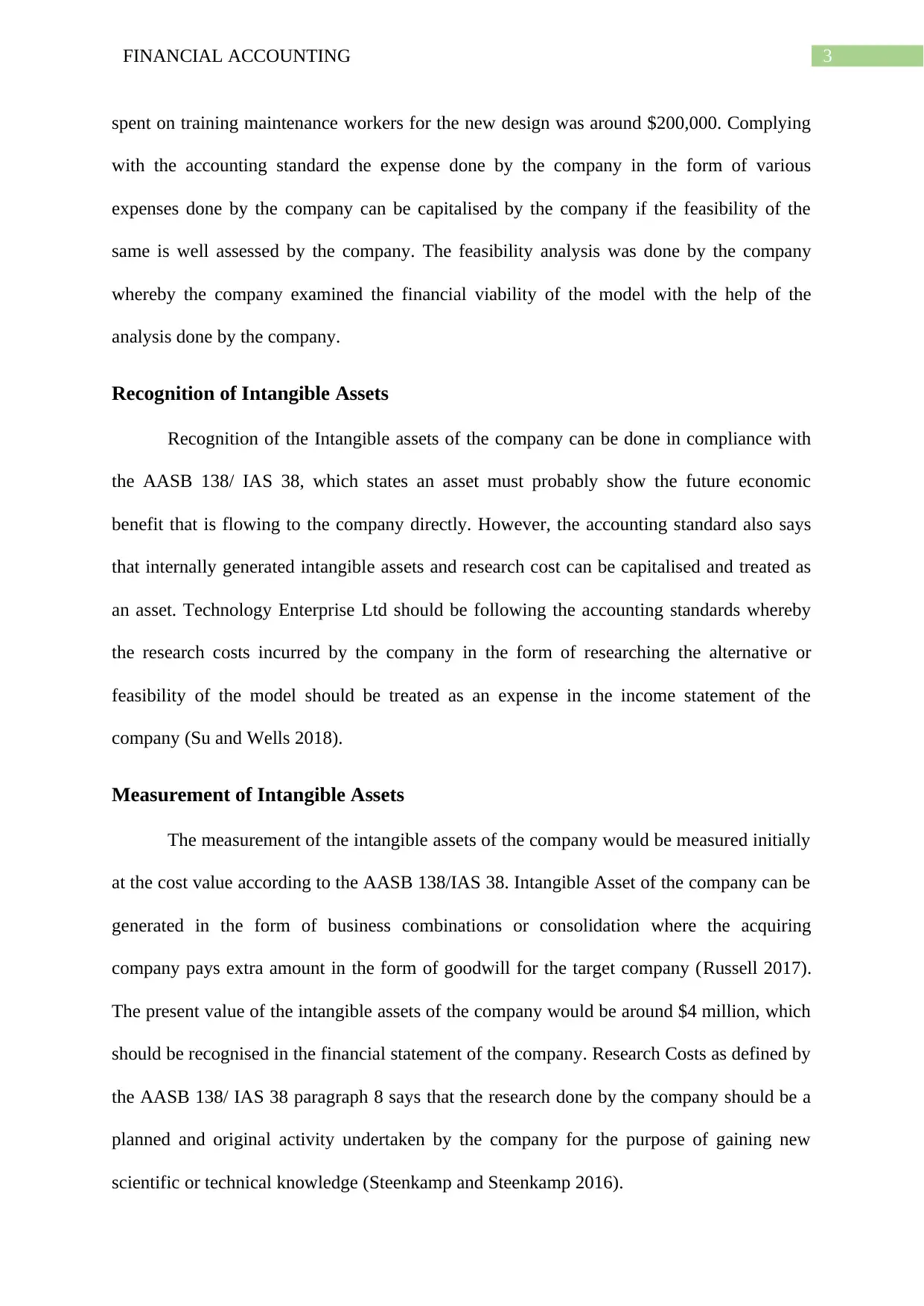
3FINANCIAL ACCOUNTING
spent on training maintenance workers for the new design was around $200,000. Complying
with the accounting standard the expense done by the company in the form of various
expenses done by the company can be capitalised by the company if the feasibility of the
same is well assessed by the company. The feasibility analysis was done by the company
whereby the company examined the financial viability of the model with the help of the
analysis done by the company.
Recognition of Intangible Assets
Recognition of the Intangible assets of the company can be done in compliance with
the AASB 138/ IAS 38, which states an asset must probably show the future economic
benefit that is flowing to the company directly. However, the accounting standard also says
that internally generated intangible assets and research cost can be capitalised and treated as
an asset. Technology Enterprise Ltd should be following the accounting standards whereby
the research costs incurred by the company in the form of researching the alternative or
feasibility of the model should be treated as an expense in the income statement of the
company (Su and Wells 2018).
Measurement of Intangible Assets
The measurement of the intangible assets of the company would be measured initially
at the cost value according to the AASB 138/IAS 38. Intangible Asset of the company can be
generated in the form of business combinations or consolidation where the acquiring
company pays extra amount in the form of goodwill for the target company (Russell 2017).
The present value of the intangible assets of the company would be around $4 million, which
should be recognised in the financial statement of the company. Research Costs as defined by
the AASB 138/ IAS 38 paragraph 8 says that the research done by the company should be a
planned and original activity undertaken by the company for the purpose of gaining new
scientific or technical knowledge (Steenkamp and Steenkamp 2016).
spent on training maintenance workers for the new design was around $200,000. Complying
with the accounting standard the expense done by the company in the form of various
expenses done by the company can be capitalised by the company if the feasibility of the
same is well assessed by the company. The feasibility analysis was done by the company
whereby the company examined the financial viability of the model with the help of the
analysis done by the company.
Recognition of Intangible Assets
Recognition of the Intangible assets of the company can be done in compliance with
the AASB 138/ IAS 38, which states an asset must probably show the future economic
benefit that is flowing to the company directly. However, the accounting standard also says
that internally generated intangible assets and research cost can be capitalised and treated as
an asset. Technology Enterprise Ltd should be following the accounting standards whereby
the research costs incurred by the company in the form of researching the alternative or
feasibility of the model should be treated as an expense in the income statement of the
company (Su and Wells 2018).
Measurement of Intangible Assets
The measurement of the intangible assets of the company would be measured initially
at the cost value according to the AASB 138/IAS 38. Intangible Asset of the company can be
generated in the form of business combinations or consolidation where the acquiring
company pays extra amount in the form of goodwill for the target company (Russell 2017).
The present value of the intangible assets of the company would be around $4 million, which
should be recognised in the financial statement of the company. Research Costs as defined by
the AASB 138/ IAS 38 paragraph 8 says that the research done by the company should be a
planned and original activity undertaken by the company for the purpose of gaining new
scientific or technical knowledge (Steenkamp and Steenkamp 2016).
Paraphrase This Document
Need a fresh take? Get an instant paraphrase of this document with our AI Paraphraser
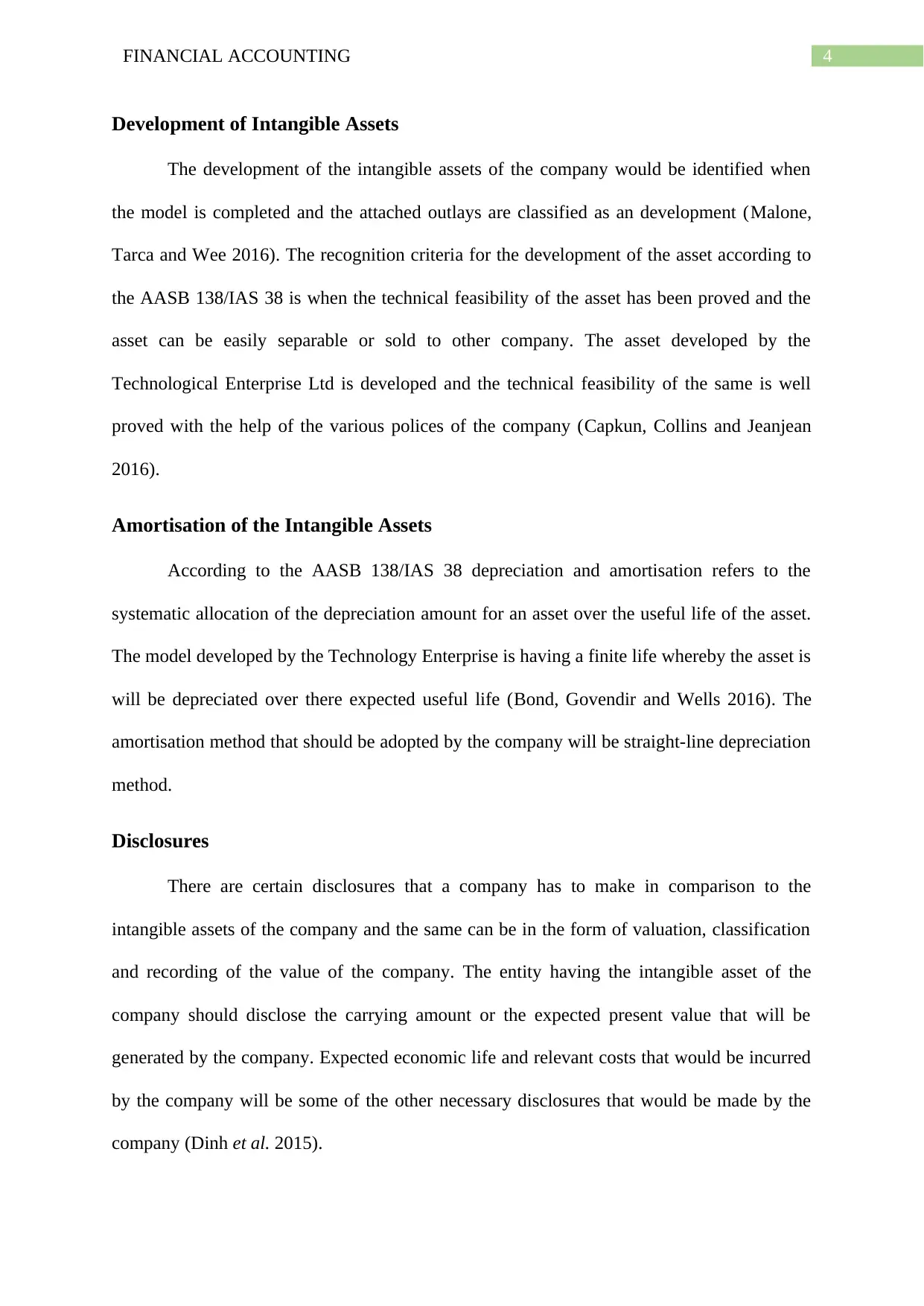
4FINANCIAL ACCOUNTING
Development of Intangible Assets
The development of the intangible assets of the company would be identified when
the model is completed and the attached outlays are classified as an development (Malone,
Tarca and Wee 2016). The recognition criteria for the development of the asset according to
the AASB 138/IAS 38 is when the technical feasibility of the asset has been proved and the
asset can be easily separable or sold to other company. The asset developed by the
Technological Enterprise Ltd is developed and the technical feasibility of the same is well
proved with the help of the various polices of the company (Capkun, Collins and Jeanjean
2016).
Amortisation of the Intangible Assets
According to the AASB 138/IAS 38 depreciation and amortisation refers to the
systematic allocation of the depreciation amount for an asset over the useful life of the asset.
The model developed by the Technology Enterprise is having a finite life whereby the asset is
will be depreciated over there expected useful life (Bond, Govendir and Wells 2016). The
amortisation method that should be adopted by the company will be straight-line depreciation
method.
Disclosures
There are certain disclosures that a company has to make in comparison to the
intangible assets of the company and the same can be in the form of valuation, classification
and recording of the value of the company. The entity having the intangible asset of the
company should disclose the carrying amount or the expected present value that will be
generated by the company. Expected economic life and relevant costs that would be incurred
by the company will be some of the other necessary disclosures that would be made by the
company (Dinh et al. 2015).
Development of Intangible Assets
The development of the intangible assets of the company would be identified when
the model is completed and the attached outlays are classified as an development (Malone,
Tarca and Wee 2016). The recognition criteria for the development of the asset according to
the AASB 138/IAS 38 is when the technical feasibility of the asset has been proved and the
asset can be easily separable or sold to other company. The asset developed by the
Technological Enterprise Ltd is developed and the technical feasibility of the same is well
proved with the help of the various polices of the company (Capkun, Collins and Jeanjean
2016).
Amortisation of the Intangible Assets
According to the AASB 138/IAS 38 depreciation and amortisation refers to the
systematic allocation of the depreciation amount for an asset over the useful life of the asset.
The model developed by the Technology Enterprise is having a finite life whereby the asset is
will be depreciated over there expected useful life (Bond, Govendir and Wells 2016). The
amortisation method that should be adopted by the company will be straight-line depreciation
method.
Disclosures
There are certain disclosures that a company has to make in comparison to the
intangible assets of the company and the same can be in the form of valuation, classification
and recording of the value of the company. The entity having the intangible asset of the
company should disclose the carrying amount or the expected present value that will be
generated by the company. Expected economic life and relevant costs that would be incurred
by the company will be some of the other necessary disclosures that would be made by the
company (Dinh et al. 2015).
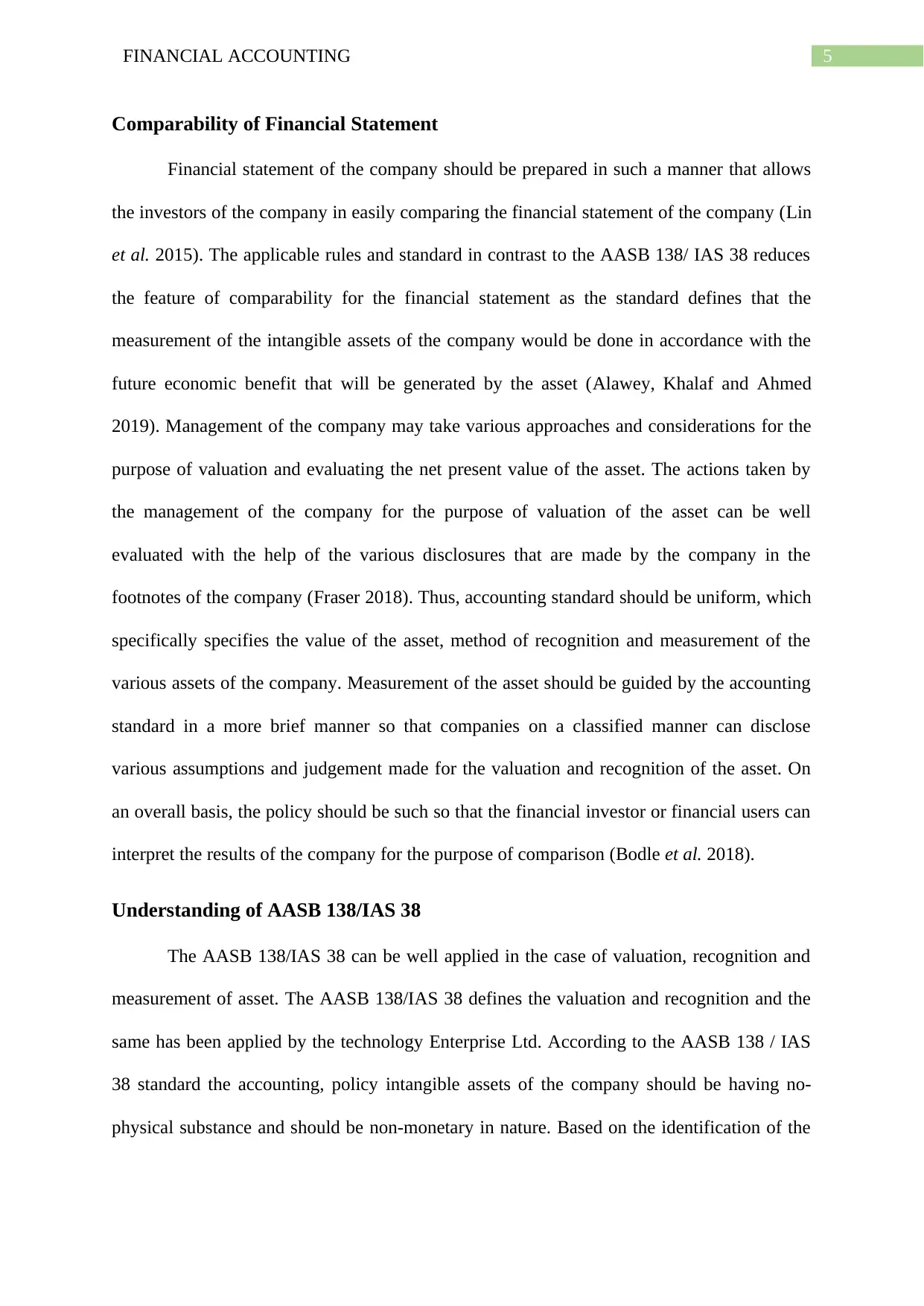
5FINANCIAL ACCOUNTING
Comparability of Financial Statement
Financial statement of the company should be prepared in such a manner that allows
the investors of the company in easily comparing the financial statement of the company (Lin
et al. 2015). The applicable rules and standard in contrast to the AASB 138/ IAS 38 reduces
the feature of comparability for the financial statement as the standard defines that the
measurement of the intangible assets of the company would be done in accordance with the
future economic benefit that will be generated by the asset (Alawey, Khalaf and Ahmed
2019). Management of the company may take various approaches and considerations for the
purpose of valuation and evaluating the net present value of the asset. The actions taken by
the management of the company for the purpose of valuation of the asset can be well
evaluated with the help of the various disclosures that are made by the company in the
footnotes of the company (Fraser 2018). Thus, accounting standard should be uniform, which
specifically specifies the value of the asset, method of recognition and measurement of the
various assets of the company. Measurement of the asset should be guided by the accounting
standard in a more brief manner so that companies on a classified manner can disclose
various assumptions and judgement made for the valuation and recognition of the asset. On
an overall basis, the policy should be such so that the financial investor or financial users can
interpret the results of the company for the purpose of comparison (Bodle et al. 2018).
Understanding of AASB 138/IAS 38
The AASB 138/IAS 38 can be well applied in the case of valuation, recognition and
measurement of asset. The AASB 138/IAS 38 defines the valuation and recognition and the
same has been applied by the technology Enterprise Ltd. According to the AASB 138 / IAS
38 standard the accounting, policy intangible assets of the company should be having no-
physical substance and should be non-monetary in nature. Based on the identification of the
Comparability of Financial Statement
Financial statement of the company should be prepared in such a manner that allows
the investors of the company in easily comparing the financial statement of the company (Lin
et al. 2015). The applicable rules and standard in contrast to the AASB 138/ IAS 38 reduces
the feature of comparability for the financial statement as the standard defines that the
measurement of the intangible assets of the company would be done in accordance with the
future economic benefit that will be generated by the asset (Alawey, Khalaf and Ahmed
2019). Management of the company may take various approaches and considerations for the
purpose of valuation and evaluating the net present value of the asset. The actions taken by
the management of the company for the purpose of valuation of the asset can be well
evaluated with the help of the various disclosures that are made by the company in the
footnotes of the company (Fraser 2018). Thus, accounting standard should be uniform, which
specifically specifies the value of the asset, method of recognition and measurement of the
various assets of the company. Measurement of the asset should be guided by the accounting
standard in a more brief manner so that companies on a classified manner can disclose
various assumptions and judgement made for the valuation and recognition of the asset. On
an overall basis, the policy should be such so that the financial investor or financial users can
interpret the results of the company for the purpose of comparison (Bodle et al. 2018).
Understanding of AASB 138/IAS 38
The AASB 138/IAS 38 can be well applied in the case of valuation, recognition and
measurement of asset. The AASB 138/IAS 38 defines the valuation and recognition and the
same has been applied by the technology Enterprise Ltd. According to the AASB 138 / IAS
38 standard the accounting, policy intangible assets of the company should be having no-
physical substance and should be non-monetary in nature. Based on the identification of the
⊘ This is a preview!⊘
Do you want full access?
Subscribe today to unlock all pages.

Trusted by 1+ million students worldwide
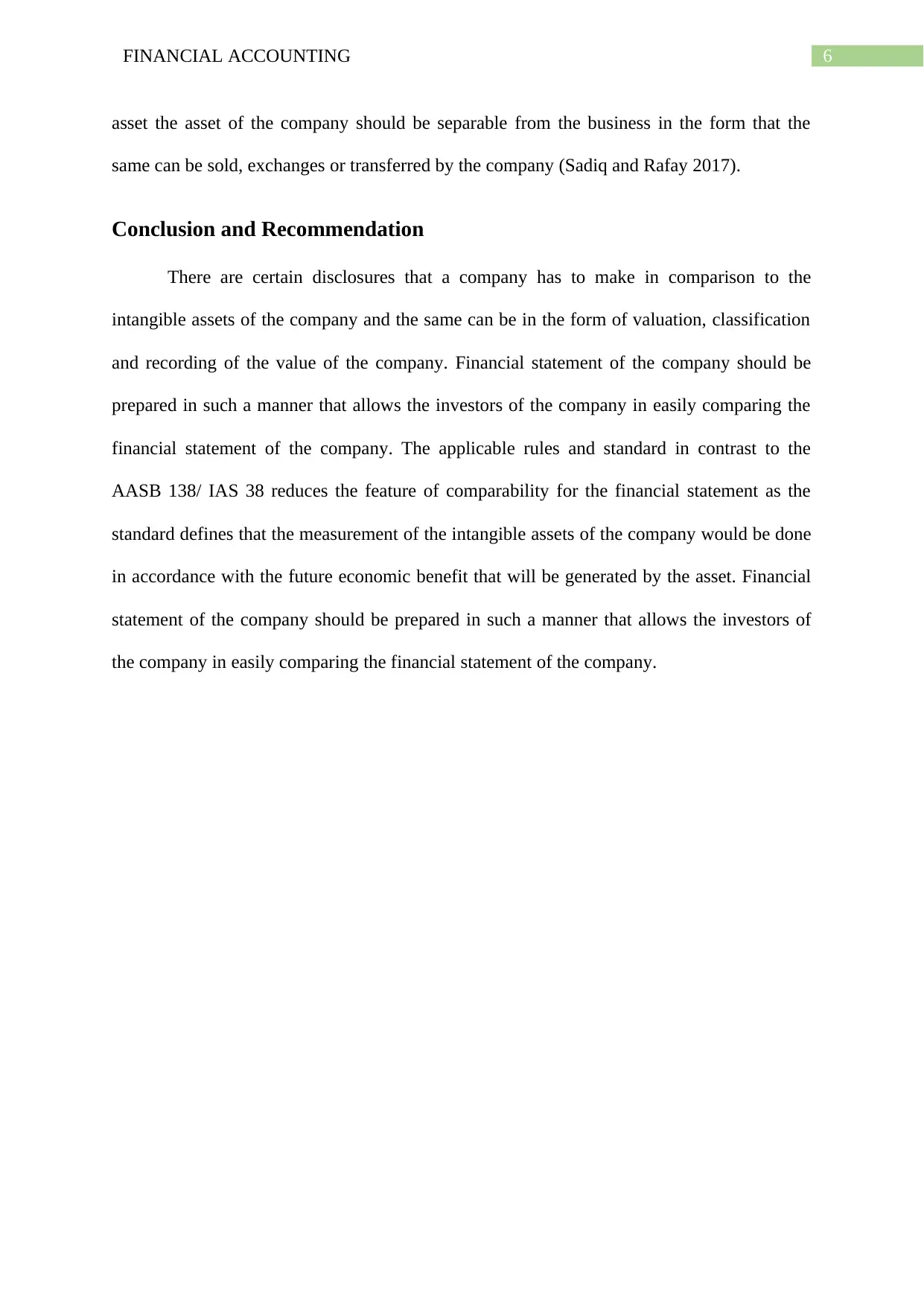
6FINANCIAL ACCOUNTING
asset the asset of the company should be separable from the business in the form that the
same can be sold, exchanges or transferred by the company (Sadiq and Rafay 2017).
Conclusion and Recommendation
There are certain disclosures that a company has to make in comparison to the
intangible assets of the company and the same can be in the form of valuation, classification
and recording of the value of the company. Financial statement of the company should be
prepared in such a manner that allows the investors of the company in easily comparing the
financial statement of the company. The applicable rules and standard in contrast to the
AASB 138/ IAS 38 reduces the feature of comparability for the financial statement as the
standard defines that the measurement of the intangible assets of the company would be done
in accordance with the future economic benefit that will be generated by the asset. Financial
statement of the company should be prepared in such a manner that allows the investors of
the company in easily comparing the financial statement of the company.
asset the asset of the company should be separable from the business in the form that the
same can be sold, exchanges or transferred by the company (Sadiq and Rafay 2017).
Conclusion and Recommendation
There are certain disclosures that a company has to make in comparison to the
intangible assets of the company and the same can be in the form of valuation, classification
and recording of the value of the company. Financial statement of the company should be
prepared in such a manner that allows the investors of the company in easily comparing the
financial statement of the company. The applicable rules and standard in contrast to the
AASB 138/ IAS 38 reduces the feature of comparability for the financial statement as the
standard defines that the measurement of the intangible assets of the company would be done
in accordance with the future economic benefit that will be generated by the asset. Financial
statement of the company should be prepared in such a manner that allows the investors of
the company in easily comparing the financial statement of the company.
Paraphrase This Document
Need a fresh take? Get an instant paraphrase of this document with our AI Paraphraser
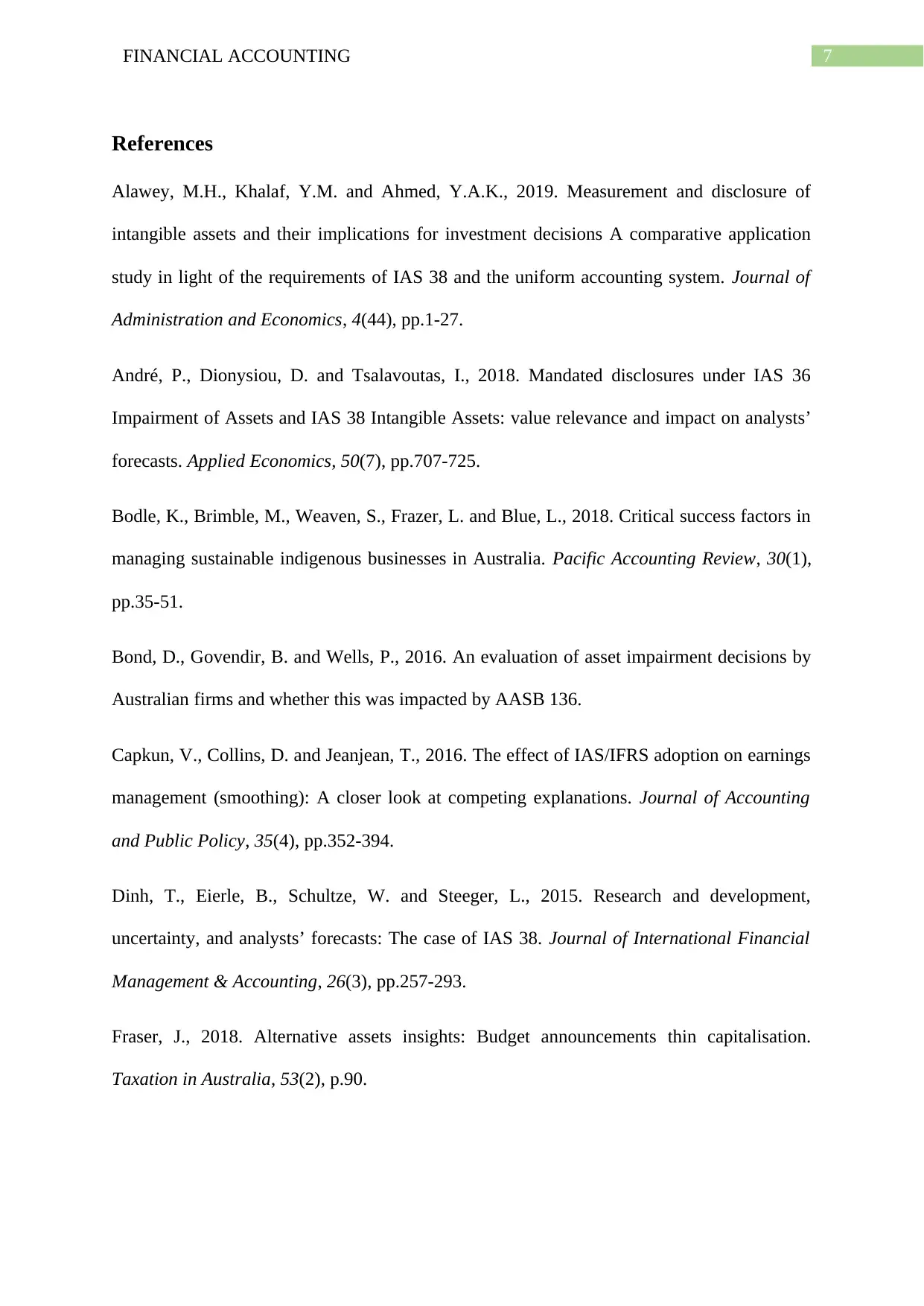
7FINANCIAL ACCOUNTING
References
Alawey, M.H., Khalaf, Y.M. and Ahmed, Y.A.K., 2019. Measurement and disclosure of
intangible assets and their implications for investment decisions A comparative application
study in light of the requirements of IAS 38 and the uniform accounting system. Journal of
Administration and Economics, 4(44), pp.1-27.
André, P., Dionysiou, D. and Tsalavoutas, I., 2018. Mandated disclosures under IAS 36
Impairment of Assets and IAS 38 Intangible Assets: value relevance and impact on analysts’
forecasts. Applied Economics, 50(7), pp.707-725.
Bodle, K., Brimble, M., Weaven, S., Frazer, L. and Blue, L., 2018. Critical success factors in
managing sustainable indigenous businesses in Australia. Pacific Accounting Review, 30(1),
pp.35-51.
Bond, D., Govendir, B. and Wells, P., 2016. An evaluation of asset impairment decisions by
Australian firms and whether this was impacted by AASB 136.
Capkun, V., Collins, D. and Jeanjean, T., 2016. The effect of IAS/IFRS adoption on earnings
management (smoothing): A closer look at competing explanations. Journal of Accounting
and Public Policy, 35(4), pp.352-394.
Dinh, T., Eierle, B., Schultze, W. and Steeger, L., 2015. Research and development,
uncertainty, and analysts’ forecasts: The case of IAS 38. Journal of International Financial
Management & Accounting, 26(3), pp.257-293.
Fraser, J., 2018. Alternative assets insights: Budget announcements thin capitalisation.
Taxation in Australia, 53(2), p.90.
References
Alawey, M.H., Khalaf, Y.M. and Ahmed, Y.A.K., 2019. Measurement and disclosure of
intangible assets and their implications for investment decisions A comparative application
study in light of the requirements of IAS 38 and the uniform accounting system. Journal of
Administration and Economics, 4(44), pp.1-27.
André, P., Dionysiou, D. and Tsalavoutas, I., 2018. Mandated disclosures under IAS 36
Impairment of Assets and IAS 38 Intangible Assets: value relevance and impact on analysts’
forecasts. Applied Economics, 50(7), pp.707-725.
Bodle, K., Brimble, M., Weaven, S., Frazer, L. and Blue, L., 2018. Critical success factors in
managing sustainable indigenous businesses in Australia. Pacific Accounting Review, 30(1),
pp.35-51.
Bond, D., Govendir, B. and Wells, P., 2016. An evaluation of asset impairment decisions by
Australian firms and whether this was impacted by AASB 136.
Capkun, V., Collins, D. and Jeanjean, T., 2016. The effect of IAS/IFRS adoption on earnings
management (smoothing): A closer look at competing explanations. Journal of Accounting
and Public Policy, 35(4), pp.352-394.
Dinh, T., Eierle, B., Schultze, W. and Steeger, L., 2015. Research and development,
uncertainty, and analysts’ forecasts: The case of IAS 38. Journal of International Financial
Management & Accounting, 26(3), pp.257-293.
Fraser, J., 2018. Alternative assets insights: Budget announcements thin capitalisation.
Taxation in Australia, 53(2), p.90.
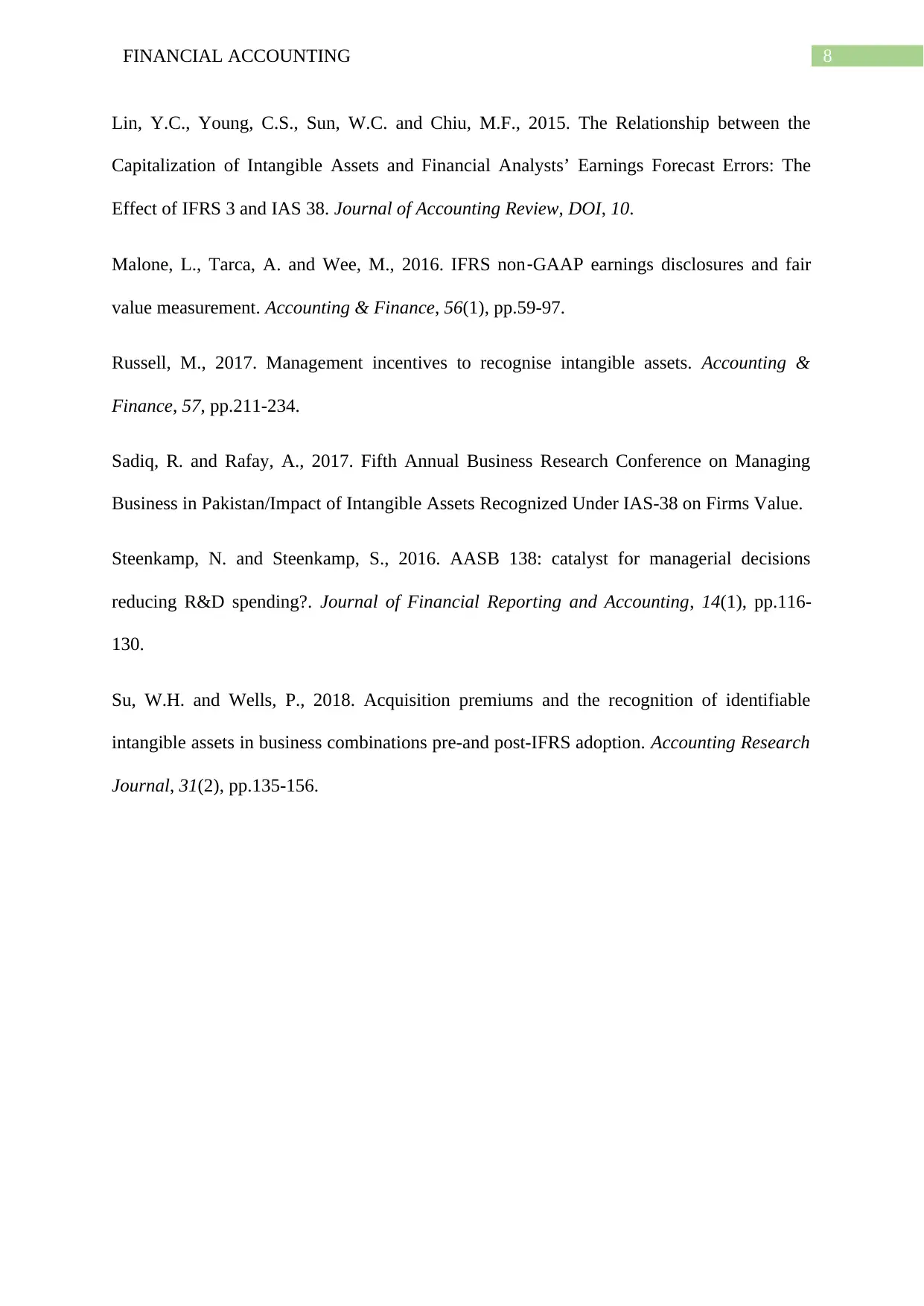
8FINANCIAL ACCOUNTING
Lin, Y.C., Young, C.S., Sun, W.C. and Chiu, M.F., 2015. The Relationship between the
Capitalization of Intangible Assets and Financial Analysts’ Earnings Forecast Errors: The
Effect of IFRS 3 and IAS 38. Journal of Accounting Review, DOI, 10.
Malone, L., Tarca, A. and Wee, M., 2016. IFRS non‐GAAP earnings disclosures and fair
value measurement. Accounting & Finance, 56(1), pp.59-97.
Russell, M., 2017. Management incentives to recognise intangible assets. Accounting &
Finance, 57, pp.211-234.
Sadiq, R. and Rafay, A., 2017. Fifth Annual Business Research Conference on Managing
Business in Pakistan/Impact of Intangible Assets Recognized Under IAS-38 on Firms Value.
Steenkamp, N. and Steenkamp, S., 2016. AASB 138: catalyst for managerial decisions
reducing R&D spending?. Journal of Financial Reporting and Accounting, 14(1), pp.116-
130.
Su, W.H. and Wells, P., 2018. Acquisition premiums and the recognition of identifiable
intangible assets in business combinations pre-and post-IFRS adoption. Accounting Research
Journal, 31(2), pp.135-156.
Lin, Y.C., Young, C.S., Sun, W.C. and Chiu, M.F., 2015. The Relationship between the
Capitalization of Intangible Assets and Financial Analysts’ Earnings Forecast Errors: The
Effect of IFRS 3 and IAS 38. Journal of Accounting Review, DOI, 10.
Malone, L., Tarca, A. and Wee, M., 2016. IFRS non‐GAAP earnings disclosures and fair
value measurement. Accounting & Finance, 56(1), pp.59-97.
Russell, M., 2017. Management incentives to recognise intangible assets. Accounting &
Finance, 57, pp.211-234.
Sadiq, R. and Rafay, A., 2017. Fifth Annual Business Research Conference on Managing
Business in Pakistan/Impact of Intangible Assets Recognized Under IAS-38 on Firms Value.
Steenkamp, N. and Steenkamp, S., 2016. AASB 138: catalyst for managerial decisions
reducing R&D spending?. Journal of Financial Reporting and Accounting, 14(1), pp.116-
130.
Su, W.H. and Wells, P., 2018. Acquisition premiums and the recognition of identifiable
intangible assets in business combinations pre-and post-IFRS adoption. Accounting Research
Journal, 31(2), pp.135-156.
⊘ This is a preview!⊘
Do you want full access?
Subscribe today to unlock all pages.

Trusted by 1+ million students worldwide
1 out of 9
Related Documents
Your All-in-One AI-Powered Toolkit for Academic Success.
+13062052269
info@desklib.com
Available 24*7 on WhatsApp / Email
![[object Object]](/_next/static/media/star-bottom.7253800d.svg)
Unlock your academic potential
Copyright © 2020–2025 A2Z Services. All Rights Reserved. Developed and managed by ZUCOL.





